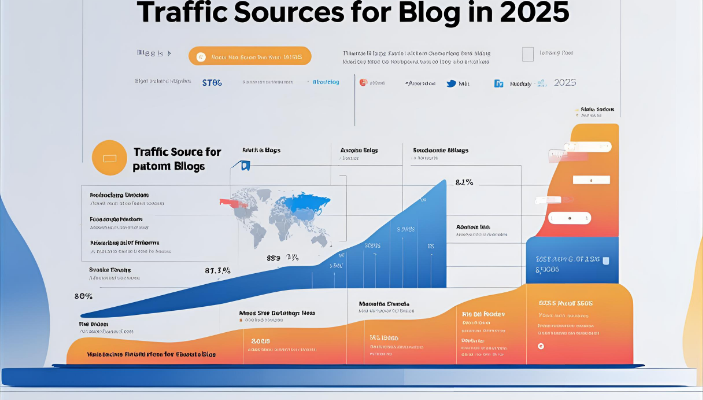If you’re running a blog in 2025, you know that traffic is the fuel that keeps your content alive. Whether you’re building a personal journal, an affiliate review site, or a niche authority platform, traffic isn’t just numbers—it’s your readers, your buyers, and your community. But not all traffic is the same, and choosing the right sources can make or break your blog’s growth this year.
This guide will walk you through the most reliable, effective, and sustainable blog traffic sources in 2025. We’ll focus on strategies that align with real human behavior and intent, using language modeled after Google NLP principles—authentic, informative, and contextually rich.
Why Blog Traffic Strategies Evolved in 2025
Over the past few years, algorithms and audience behavior have shifted dramatically. Here’s what’s different now:
- Search behavior is more conversational.
- Zero-click results are increasing, changing how traffic flows from Google.
- Social media fragmentation means you can’t rely on one platform.
- Contextual relevance and user satisfaction are key to lasting visibility.
Bloggers must now focus on sources that deliver both reach and relationship.
1. Organic Search Traffic [SEO Still Matters]
While Google remains the leading source for long-term traffic, its ecosystem in 2025 demands more than keyword stuffing or backlinks.
What Works Now:
- Semantic-rich content: Write around context, not just exact phrases.
- E-E-A-T compliance: Show real-world experience and trustworthiness.
- Structured data: Schema and enhanced markup are essential.
- Fast-loading, mobile-friendly design: Page speed is non-negotiable.
Action Tip:
Use Google Search Console regularly to find high-intent queries where your blog already ranks in the top 20—optimize those pages further for clarity and engagement.
2. YouTube as a Search Companion
More users now treat YouTube like a search engine—especially for how-to, reviews, and opinion-based content. If you’re not creating short-form or long-form video, you’re missing out.
Why It’s Effective:
- Visual search preference is growing.
- YouTube snippets often appear in Google search.
- Video builds trust and dwell time.
How Bloggers Can Use It:
- Repurpose blog posts into explainers or reviews.
- Use YouTube descriptions to link back to blog content.
- Embed YouTube videos in your posts to enhance page value.
3. Pinterest for Evergreen Blog Traffic
Pinterest remains underutilized, even though it’s one of the best long-tail, evergreen platforms for blog referral traffic—especially in niches like:
- Lifestyle
- Food
- Home
- Fitness
- Personal Finance
- DIY
What to Do:
- Create niche boards with consistent branding.
- Use descriptive pin text that mirrors search queries.
- Add alt-text on pins for better visibility.
- Pin regularly using scheduling tools like Tailwind.
4. Quora and Reddit: Building Topical Authority
In 2025, answer-based platforms like Quora and Reddit drive targeted traffic while improving your site’s topical relevance. Google increasingly values answers from platforms with active discussions.
Benefits:
- Context-rich backlinks when shared correctly.
- Positions you as a niche expert.
- Brings in traffic with high search intent.
Best Practices:
- Answer newer questions with fresh perspectives.
- Link back to your blog only when it adds value.
- Use topic-specific subreddits and avoid spamming.
5. AI Chat Integration (ChatGPT, Gemini, Claude)
As chat-based search becomes more prevalent, traffic is influenced by AI-generated summaries and link recommendations.
Opportunities:
- Mentioned sources in AI search responses drive traffic.
- Blogs with well-structured, factual content are more likely to be cited.
- AI models prefer content with strong structure, clarity, and authenticity.
Strategy:
- Use clear headings, bullet points, and Q&A.
- Keep your content factual and nuanced.
- Reference verifiable data and cite sources properly.
6. LinkedIn for Professional/Niche Blogs
If your blog targets professionals—marketing, business, tech, healthcare—LinkedIn is a high-converting traffic source.
Key Moves:
- Share blog links with contextual commentary.
- Use native documents and carousels to tease content.
- Engage in industry-specific conversations.
Tip: Repurpose long blogs into 3–5 posts with strong hooks and soft CTAs linking back.
7. Email Traffic: Still a Core Asset
Email remains the most ownership-driven traffic source. Unlike platforms that can throttle your reach, email lands directly in inboxes.
2025 Trends:
- AI-personalized newsletters.
- Reader-first designs: clean, mobile-responsive layouts.
- Short, benefit-led summaries with one strong CTA.
Grow Your List:
- Offer lead magnets aligned with reader needs.
- Use slide-ins or exit intent popups (not full-page interruptions).
8. Facebook Groups and Niche Communities
While organic Facebook page reach is low, private groups and niche communities are highly effective for traffic.
How to Leverage:
- Create your own group around your blog’s core topic.
- Share value-based posts and include contextual links.
- Engage in relevant groups with problem-solving content.
Avoid: Posting direct links without commentary.
9. Medium and Syndication Platforms
Syndicating blog posts (or parts of them) on platforms like Medium, Vocal, or Substack helps you tap into new readers who don’t yet know your brand.
Key Principles:
- Use rel=canonical or delayed reposting to avoid SEO conflicts.
- Link to your original blog post as the primary source.
- Tailor the intro to match platform tone.
10. Push Notifications and Browser Alerts
Web push notifications have become more personalized. You can now segment audiences based on behavior, location, or device.
How to Use:
- Send brief, timely updates (new posts, limited-time offers).
- Segment your audience by category of interest.
- Limit to 2–3 notifications per week to avoid fatigue.
11. Twitter/X for Fast, Timely Content
Twitter/X remains essential for trends, news, or quick updates.
Tips for 2025:
- Use threads to summarize blog content.
- Embed key takeaways as visuals or quote graphics.
- Use topic-specific hashtags to increase visibility.
Pro Tip: Don’t post a link in the first tweet of a thread—place it in the second or third.
12. Influencer Collaborations
Influencers—even micro ones—can amplify your blog traffic if done right.
Collaborate By:
- Writing guest posts for their platforms.
- Inviting them to quote or contribute to your blog.
- Sharing exclusive offers or co-branded resources.
Focus on relationships, not just exposure.
Final Thoughts: Combining Channels for Lasting Growth
The best blogs in 2025 use a multi-source strategy, not relying on one platform but weaving a network of traffic streams that align with reader intent and behavior.
Your goal isn’t just to get clicks. It’s to build a trusted brand, serve people with relevant insights, and create content that shows up where they’re already searching, scrolling, or asking questions.
FAQs
1. Which blog traffic source is best for beginners in 2025?
Organic search and Pinterest are great starting points. They’re free, scalable, and deliver consistent traffic over time.
2. Is Facebook still a good place to promote blog posts?
Yes, but focus on niche groups or create your own. Personal profiles and group engagement work better than page posts.
3. How can I get traffic without using social media?
Focus on SEO, YouTube, Quora, Reddit, and email. These platforms don’t rely on follower counts and offer long-term ROI.
4. Should I use AI tools to write blog content for traffic?
You can use AI for outlines and idea generation, but original, human-focused writing will always perform better in search and with readers.
5. How do I measure which traffic source works best?
Use Google Analytics 4 (GA4) or tools like Plausible. Track not just visitors but also time on page, bounce rate, and conversions.







